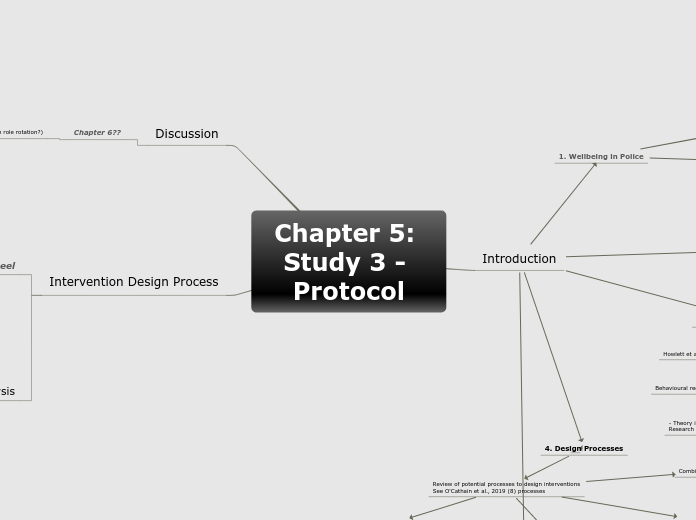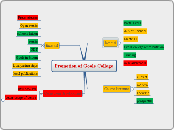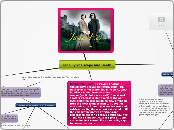Miss a whole other diamond (iteration) / principles of relationship building...
Chapter 5: Study 3 - Protocol
Intervention Design Process
Measures of Change / Analysis
The Behaviour Change Wheel
STEP 3: Develop Behaviour change techniques
Describe and justify techiques: Consequences / Environmental cues and promps / instruction on how to perform a behaviour / self-monitoring / social support
Descriptive norms (Kim et al., 2017 PA; Preibe & Spink, 2011 SB)
Raising awareness - sitting invisible (Gardner et al., 2019)
STEP 2: Intervention functions
Feasibility of options through shift shadowing
Present options to steering group, with consideration of criteria
Discuss, justify and agree options with supervisory team
Identify what you want intervention to do: Modelling behaviour / changing habits
STEP 1: COM-B: Selecting what the intervention is aiming to do and how it is doing it
Discussing / justifying focus with supervisory team
Identify what needs to be changed
Defining the problem
Discussion
Chapter 6??
Changing personnel (6 month role rotation?)
Introduction
4. Design Processes
Review of potential processes to design interventions
See O'Cathain et al., 2019 (8) processes
Combined approach (8)
Needs to be formal?
Implementation based (4) RE-AIM
MacDoanld et al., 2018 systematic review
Low adoption and maintenance reported
Theory driven (3)
BCW
+ Widely used, BCTs comparable
- Need to make MoA & causal pathways clear
- Final decision with researcher
Koykka et al., 2019
(Action planning - habits)
+ Multiple theories - BCW, TPB, IM
+ Paid attention to context (teachers)
Descriptions of co-design principles office setting
Efficiency based (5) Stand Up Victoria
Hadgraft et al., 2016 Qual
Hadgraft et al., 2017 RCT
-> Need to understand interpersonal infl
-> Bryne et al., 2020 need context to advance field
Miller et al., 2019 review
Dunstan et al., 2013 Protocol
- Measures
Neuhaus et al., 2014
+ Iterative development
+ Multi-level, multi-component
-> Bryne et al., 2020 need causal pathways
MoA (Carey et al., 2018), need to isolate BCT effects (Hagger et al., 2020)
Double Diamond (1 - Partnership)
Target population-centred (2) Participatory
SMArT Work
Edwardson et al., 2018 RCT
+ Effective long-term
- Support measure broad
Munir et al., 2015 Protocol
+ Systematic BCW
+ Support through researcher
How as important as what!
e.g., Hardcastle et al., 2017
5. Aim and Objectives of the chapter
O'Cathain et al., 2019:
Development = whole process of int developmet
Design = Point in process where developers decide content, format, delivery
AIM: To assess the feasibility of an intervention to reduce sitting time in police control room workers
OBJ 3:
OBJ 2: To use the Behaviour Change Wheel to design an intervention that reduces sitting time in police control room workers
OBJ 1: To use a co-design approach to develop an acceptable and feasible solution to prolonged sitting in the control room context
3. Theoretical underpinning
Howlett et al., 2020 COM-B and TPB predictive validity
Habit strength
Behavioural regulation, Social influences
- Theory is only one approach
Research lending from PA?
1. Wellbeing in Police
Non-operational staff e.g., control room overlooked
Highlighting the issue: Sedentary behaviour
Impacts on wellbeing
Impacts on health
2. Worksite interventions to decrease sitting
Exertime = in police context
Cooley et al., (2014)
+ Qualitative follow-up
Quite a few qual studies:
Dewitt et al., 2019 (need org support)
Mainsbridge et al., (2020)
+ Exertime Tasmanian Police
+ Mood (POMS-SF Vigor and Fatigue) N.S., Stress (PSQ-Op&Org) Org decreased.
+ 13 week post-test, 26 week washout
- PSQ-Op?
- Small sample
- Lack theoretical underpinning needed e.g. BCW
Pedersen et al., (2013)
Mainsbridge et al., (2014)
+ Blood pressure, calories
- No follow up
Stephenson et al., 2017 most freq:
Prompts and cues
Self-monitoring
Social support (unspecified)
Goal setting (beh)
-> Need improved reporting
Shrestha et al., 2018 Cochrane review
->Sit-stand desks not effective









